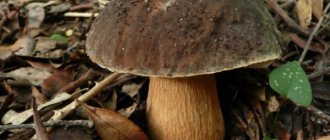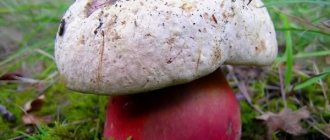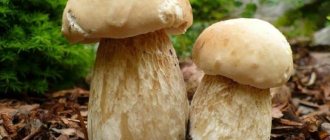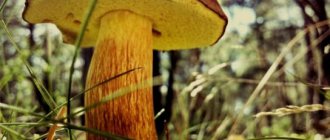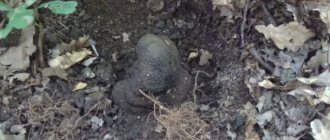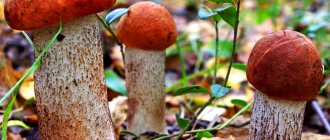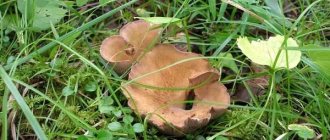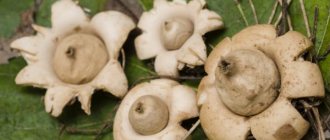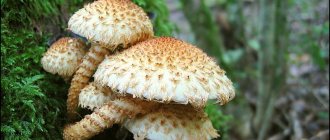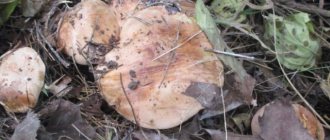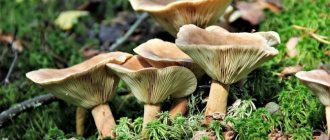Mushrooms of this family are quite monotonous. They only grow for a few days and are fleshy. Their structure is the same: a cap and a central leg.
At the bottom of the cap there is a tubular layer that is usually easily separated from the cap. Usually its diameter varies up to 20 cm. Mushrooms can weigh from a few grams to 4 kg. Boletus mushrooms grow mainly in forests. Mushrooms of this family are usually edible. True, there are inedible ones - due to the bitter and unpleasant taste of the cap.
White birch mushroom
Edible mushroom.
It has excellent taste.
It differs from other porcini mushrooms in its larger and fleshier fruiting body. The cap can reach 22 cm, but there are also larger mushrooms - with a cap diameter of 25-27 cm; it is smooth or thin-felt, in wet weather it becomes slightly slimy, in dry weather it can...
- Read more…
Ecology DIRECTORY
Boletus fungi can form mycorrhizae with one, several or even many tree species, systematically sometimes very distant from each other (for example, coniferous and deciduous). But it is often observed that a fungus of one species or another is confined to trees of only one species or one genus: larch, birch, etc. Within the same genus - to individual species - they usually turn out to be “insensitive”. However, in the case of the genus of pine (Rtiv), there is a greater association not with the entire genus as a whole, but with its two subgenera: two-coniferous pines (for example, Scots pine) and five-coniferous pines (for example, Siberian cedar). It is impossible not to note such cases when some mycorrhizal fungi, isolated from tree roots, can apparently develop as saprophytes, content with litter (fallen needles, leaves, rotten wood) of those tree species with which they usually form yikoriza. For example, a porcini mushroom was found on top of a huge boulder in a pine forest, and Asian boletin (a companion of larch) was found on a high rotten stump of a birch tree that grew in a larch forest.[...]
Boletus mushrooms are eaten, like other agaric mushrooms, fresh (boiled, fried) or canned in one way or another, but they are rarely salted compared to other mushrooms.[...]
The mycelium of boletus fungi in culture in representatives of some genera (Boletinus, Suillus, Xerocomus) develops somewhat better than in others (Leccinuni, Boletus). Boletaceae spores generally germinate with great difficulty; sometimes this was achieved only after adding yeast or bacteria to the fungal culture.[...]
The mycelium of boletus fungi in culture in representatives of some genera (Boletinus, Suillus, Xerocomus) develops somewhat better than in others (Leccinuni, Boletus). Boletaceae spores generally germinate with great difficulty; sometimes this was achieved only after adding yeast or bacteria to the fungal culture.[...]
The fruiting bodies of boletus mushrooms are morphologically quite uniform. All of them are not only annual, but also ephemeral, growing for only a few days, fleshy, consisting of a cap and usually a central stalk. At the bottom of the cap there is a spongy (tubular) hymenophore, which extremely rarely turns into a lamellar hymenophore, which, as a rule, is easily separated from the tissue of the cap. [...]
Comparing the species composition of boletus fungi of various forest formations, it was found that a larger number of species grow in spruce forests (16 species or 61.5%). This can be explained by the most favorable natural conditions in these habitats, as well as the presence of birch, pine and cedar in the forest stand as an admixture. The leading families here are Boletaceae (8 species), Gomphidiaceae (8 species), Strobilomycetaceae (2 species). For pine forests, 12 species (46.2%) from the order Boletales were recorded. The families Boletaceae (seven species) and Gyrodontaceae (three species) predominate here. Four species (15.4%) grow in deciduous forests: Boletus betulicola, Leccinum aurantiacum, L. scab rum and Chalciporus pi pera tus.[...]
It is known that the fruiting bodies of boletaceae contain antiblastic substances that act against malignant tumors in mice. Of these species, both the white mushroom (Boletus edulis) and the satanic mushroom (B. satanas, Table 34) are known. However, there is no information about further research in this direction.[...]
In the hot desert zone, boletaceae are absent. In the tropical forest zone they reappear, but in a very small number of species. In the temperate zone of the southern hemisphere there are also few of them, and in the southern cold zone, in Antarctica, they are absent. Moreover, they are distributed very unevenly in the same zone. Thus, in the northern temperate zone, cold-resistant species go far to the north and move into the tundra, while more heat-loving species, on the contrary, are limited to moderate or even only the warmest southern latitudes.[...]
As for poisonous mushrooms, there are apparently no such mushrooms among the Boletaceae. Only very few of them are inedible due to the bitter or generally unpleasant taste of the pulp (this will be discussed when describing individual species). In Eurasian conditions, there are no more than a dozen such species. True, in the literature, especially in Western Europe, the presence of poisonous and even very poisonous species among boletaceae was and is now often noted. But recently, information about it has increasingly begun to appear, especially in French and Czechoslovak literature, as a completely edible and even tasty (boiled and fried) mushroom. The notoriety of the satanic mushroom may have arisen and spread because it was tried to be eaten directly raw (for example, in salads), without cooking, and in such cases unpleasant gastric phenomena actually occurred from it, no deaths were recorded. [... ]
Before moving on to a systematic description of boletus mushrooms, we need to dwell a little on the Russian names that are applied to them. [...]
In terms of its geographical distribution, the Boletaceae family is cosmopolitan, except for Antarctica, covering all continents, but at the same time its individual genera and species are distributed very unevenly. The vast majority of mushrooms grow in temperate forests of Eurasia and North America. The greatest diversity of their species is also concentrated here. As a result, it can be assumed that the origin of boletus fungi is mainly associated with temperate latitudes.[...]
Probably, due to the fact that the vast majority of boletus fungi species are mycorrhiza-formers, in culture they, as a rule, cannot be brought to fruiting and therefore they are not artificially bred. The exceptions are two closely related species of flywheels that grow on wood and from which fruiting bodies were obtained in culture (p. 268).[...]
The structure of the cap, hymenophore, and surface of the stalk is of great systematic importance for determining the genera and species of boletaceae. The surface of the cap can be smooth, wrinkled, wavy, dry or wet. [...]
In connection with what has just been said, the yield of boletus mushrooms per unit area is also very different. According to available information, for example, the yield of porcini mushroom under favorable growing conditions reaches about 500 kg, and even almost 1000 kg of fresh mushrooms per hectare. At the same time, in lean years you can get only a few kilograms from 1 hectare or nothing at all. When calculating mushroom reserves, an average of 100 kg per hectare is sometimes taken. However, yields are often reduced significantly, and in some years even to the point of being completely destroyed by insect pests. The maximum damage to boletus mushrooms is caused by the larvae of flies from the family Muscidae, while almost all agaric fungi are caused by the larvae of forest mosquitoes from the family Mycetophilidae. As for fungal pests, they are very rare on living fruiting bodies of boletaceae. Relatively more often, representatives of the genus Sepedonium can be found, especially S. chrysospermum, usually developing on the underside of the cap, first in the form of white, then bright golden-yellow mold, in which its bright golden-yellow warty spores are easily visible under a microscope (chlamydospores).[...]
Now it is interesting to look at how mushroom pickers and authors of specialized literature in Russia and the USSR treated this position about the toxicity of the noted boletus mushrooms. First of all, boletus mushroom collectors never ate them raw. Due to its rare occurrence and insignificant abundance, the satanic mushroom, as a rule, was not at all familiar to our collectors or did not differ from the usual types of oak - olive-brown and speckled. As for these latter, where they grow, they were usually used and are now used for food, fried or boiled. Thus, the question of their toxicity did not even arise and does not arise. True, some people were sometimes put off by the bright color of the mushroom and the bluish discoloration of the flesh at the break. They did not take such mushrooms or used them only after preliminary boiling.[...]
The material for this work was samples collected during the 2000-2004 field season. in various landscape areas of the reserve. As a result of the research, 27 species of boletus fungi were identified, belonging to seven families and 13 genera. The leading family in terms of the number of species is the Boletaceae family (15 species). The leading genera are Suillus (8 species), Leccinum (4 species), Boletus (3 species), Boletin us (2), Gomphidius (2). The remaining eight genera are single-species.[...]
These are all species of the families Boletaceae, Gomphidiaceae, Gyrodontaceae, Hygrophoropsidaceae and Xerocomaceae. Only three species are inedible (Chalciporus piperatus, Tylopilus feile us and Tapinella atrotomentosa). One type of boletus mushroom is poisonous - Paxillus involutus.[...]
Mushrooms of all species of this genus are mycorrhiza-formers with coniferous trees of the pine family. This connects the distribution of morukhova with the distribution of pine.[...]
It should also be noted that in artificially created forest plantations of one or another tree species, the especially characteristic species of mycorrhizal fungi accompanying them are sometimes found very far from the boundaries of their natural range. In addition to tree species, the type of forest, type of soil, its humidity, acidity, etc. are of great importance for the growth of boletus mushrooms [...]
Asia, the Caucasus, as well as the central and eastern regions of the country, for example Tatars, Bashkirs. And vice versa, Russians, no matter where they live, are big fans of mushrooms, and not only in the sense of using them for food, but consider even collecting them a great pleasure. However, even among them, the number of mushrooms collected is not completely constant and is subject to significant fluctuations. The latter depends to a large extent on the area where they live, on what types of mushrooms grow there, as well as on their harvest. In harvest years, only the most valuable types of mushrooms are usually collected; in barren and very overpopulated areas, as a rule, everything is collected, including the least valuable. The most famous and expensive in the family of boletaceae and all mushrooms in general in the USSR is the porcini mushroom, which belongs to the 1st category of value; then come Osipovik, Berezovik, boletus - to the 2nd category; moss mushrooms are usually classified in the 3rd category, and such as goats and boletins are classified in the 4th category.[...]
Spruce porcini mushroom
Edible mushroom.
The mushroom is highly valued for its high taste.
The mushroom is large (its weight can reach 2 kg). Its cap reaches 20-25 cm in diameter, is smooth or thin-felt, and in wet weather is slightly slimy. At first the cap is hemispherical, then cushion-shaped, brownish-brown.
The pulp is dense, white, at the break...
- Read more…
White pine mushroom
Edible mushroom.
Possessing excellent taste.
cap can reach 25 cm in diameter. As a rule, it is smooth and fibrous. The pine porcini mushroom differs from other porcini mushrooms in its hemispherical and slightly flattened shape, chocolate-brown, less often dark cherry-colored cap and a thicker tuberous but...
- Read more…
In cooking
Semi-bronze bolet in ready-made dishes has tender flesh and a soft, pleasant, pronounced taste and a delicate, rich, mushroom aroma. It is valued in the same way as porcini mushroom. Connoisseurs of mushroom cooking classify this species as a delicacy.
The flesh of the semi-bronze bolete is thick, fleshy, dense, and elastic. During cooking, it retains its shape and texture well and does not fall apart.
Information! The product is low-calorie. The calorie content of semi-bronze bolet is 22-30 kcal per 100 g. product.
Based on this, you shouldn’t think about what to cook from semi-bronze bolet. The mushroom is universal, suitable for all types of culinary processing: it is boiled, fried, stewed. There are many recipes for semi-bronze boletome. It can be used in the same dishes as porcini mushroom.
White mushroom, Boletus
Edible mushroom.
This mushroom is a mushroom to all mushrooms, it’s not for nothing that the people called him “Colonel”, and no one will demote him! It’s so delicious, it’s so good even in pies or mushroom cabbage soup!
The porcini mushroom has a grooved cap with a diameter of 6-25 cm, it is dark chestnut-brown in color. In young mushrooms it is spherical, but gradually becomes...
- Read more…
Royal bolet
Edible mushroom.
This mushroom is tasty, but since the population of this species has recently declined sharply, it is better not to collect it.
cap is initially spherical in shape. It gradually increases in diameter to 8-15 cm. The color of the cap is reddish or blood red on pink or pale yellow ground. In the darkest...
- Read more…
Degree of toxicity of eukaryotes
The issue of dietary consumption of the satanic mushroom has not yet been completely resolved. But scientists still came to one unanimous opinion: in its raw form, boletus is incredibly dangerous and toxic. According to scientific research, a small piece of pulp, whose weight does not exceed 1 gram, contains a high concentration of poison. It can cause severe digestive upset, which may require hospitalization in some patients.
Scientists are divided into two groups: some believe that the concentration of poison decreases to a conditionally safe level after prolonged cooking, others argue that toxins do not go away and even after heat treatment can harm a person.
Bolet semi-white
Edible mushroom.
This mushroom is rare and should be preserved.
Young mushrooms have a hemispherical cap, old mushrooms have a convex, cushion-shaped or slightly flatter, sometimes wide, with a tubercle. The diameter of the cap is from 5 to 12 cm. The skin is silky-felt, later smooth, but not oily, colored in various shades: from pale…
- Read more…
Habitat
Semi-bronze boletus is a heat-loving mushroom and, although it is quite widespread in the CIS, it is not common. The main regions of growth of this species are the south with a hot climate and high rainfall. Prefers hilly terrain and moist, humus-rich soils.
Grows in small groups consisting of 2-3 copies, or singly.
Information! In addition to the CIS countries, semi-bronze has become widespread in some regions of Europe.
Where does it grow
Semi-bronze bolet forms mycorrhiza (symbiosis with the roots of the plant) with oak, beech, and pine.
Many, especially beginners, mushroom pickers are interested in where they collect semi-bronze boletus. This species can be found in deciduous, coniferous, and mixed forests.
Boletinus polypeduncle
Edible mushroom.
Mushroom with good taste.
The mushroom is easy to recognize by its hollow stalk, red-brown scaly cap and wide edges of the tubes. Boletinus polnopodkovy has a rough red-brown cap with a diameter of 4-12 cm. The edges of the tubes are wide, yellow or green-yellow.
The pulp is yellowish, does not change...
- Read more…
Related species
The semi-bronze boletus has many relatives: the boletus or boletus genus is quite numerous and includes about 300 species, among which there are both edible, conditionally edible, and inedible (non-toxic), toxic and poisonous.
Edible species include:
- maiden boletus (brown-yellow boletus) – Boletus appendiculatus;
- bicolor boletus – Boletus bicolor;
- Burroughs boletus – Boletus barrowsii;
- Fechtner's boletus – Boletus fechtneri;
- pasture boletus (pasture boletus) – Boletus pascuus;
- yellow boletus (yellow boletus) – Boletus junquilleus, etc.
The group of inedible, toxic and poisonous species includes:
- beautiful boletus (beautiful boletus) – Boletus calopus – inedible;
- Boletus porosporus (Boletus porosporus) – inedible;
- purple boletus (pink-purple boletus) – Boletus purpureus – inedible;
- legal boletus – Boletus legaliae – toxic;
- beautiful boletus - Boletus pulcherrimus - toxic;
- satanic mushroom – Boletus satanas – toxic, etc.
Chestnut mushroom
Edible mushroom.
Valuable commercial mushroom.
The cap is from 5 to 10 cm in diameter, reddish-brown, chestnut in color, flat-convex, sometimes with curved edges, dry and smooth.
The pulp is white, does not change color, is dense, has a pleasant mushroom smell, and has a bitter taste. The tubular layer is white or yellowish-cream...
- Read more…
Beneficial features
Half-white bolet is not only tasty, but also healthy. It contains very few calories, so it is impossible to gain weight from it. The semi-white mushroom is not too heavy on the stomach and can be consumed not only by adults, but also by children over 10 years old.
Yellow boletus quickly satisfies hunger and has a beneficial effect on the kidneys, intestines, pancreas and other organs. Regular consumption of Boletus impolitus leads to the following “consequences”:
- Strengthening the immune system. Yellow boletus is extremely rich in ascorbic acid. With its regular consumption, the risk of acute respiratory viral infections, colds, tuberculosis, influenza and some other diseases is reduced. The human body strengthens and becomes less susceptible to all kinds of viruses and bacteria.
- Improving the functioning of the heart muscle. Mushrooms are very useful for people suffering from hypertension and obesity. Its caps are full of magnesium, potassium and phosphorus. Regular consumption of boletus mushrooms enriches the body with these elements. As a result, the risk of developing atherosclerosis, rheumatic manifestations, angina pectoris, high blood pressure, arrhythmia and other diseases is reduced.
- Preventing dental diseases. Semi-white bolet is incredibly rich in phosphorus, calcium and fluoride compounds. This composition has a beneficial effect on teeth, helps prevent gum disease, and saves from caries.
- Beautiful skin and hair. Semi-white mushrooms are also quite high in iron and folic acid. And these, as you know, are recognized “elements of beauty.”
- Normalization of hemoglobin. A large amount of iron and ascorbic acid allows you to prevent anemia. With regular consumption of yellow boletus, lightheadedness goes away, dizziness and general weakness disappear, and digestion is normalized.
- Strengthening bone tissue. To ensure this effect, you need to eat semi-white mushrooms. Just 200 grams of the product contains half the daily intake of calcium and phosphorus. The constant presence of yellow boletus in food prevents the development of arthrosis, rheumatism, osteochondrosis and other troubles.
It is important to know! In dried or frozen mushrooms, the original chemical composition is preserved almost completely. So the semi-white mushroom will be beneficial throughout the year.
